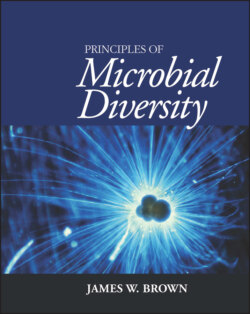Читать книгу Principles of Microbial Diversity - James W. Brown - Страница 35
Molecular phylogenetic trees
ОглавлениеIf the traditional five-kingdom tree is problematic because it is subjective and qualitative, we need an objective measure of evolutionary history. With the ability to determine the nucleotide sequences of genes beginning in the 1970s, it became possible to use variation in these gene sequences as molecular chronometers of evolutionary distance. We cover this in much detail in chapters 3 through 6, but suffice it to say for now that these sequences provide the information needed to reconstruct evolutionary trees both objectively and quantitatively (Fig. 2.6).
This example of a molecular phylogenetic tree is an unrooted dendrogram. The length of the branches quantitatively represents the evolutionary distance separating gene sequences within these organisms. This particular tree is based on the analysis of small-subunit ribosomal RNA (rRNA) gene sequences. In this tree, the tips of branches are modern organisms. Each node within the tree represents a common ancestor. The last common ancestor (the root) is marked with a star. The way this was determined is described in chapter 7.
Notice that there is no explicit or implied ranking of above (superior) or below (inferior) in the tree. Evolutionary distance (divergence) is measured along the lengths of the branches connecting species. There are no axes in this graph.
One of the most exciting early outcomes of this method was the discovery of a new type of organism: the Archaea (archaebacteria). Previously it was thought that all living things were members of either the Bacteria (eubacteria) or the Eukarya (eukaryotes). Archaeal species had previously been scattered haphazardly among whatever bacteria they superficially resembled. Indeed, in terms of superficial phenotype, the Archaea are generally similar to the Bacteria, but biochemically they are just as similar to the Eukarya, and in evolutionary terms they form a distinct group that is probably more closely related to the Eukarya than to the Bacteria. The Archaea as a group have changed less since their common ancestry than either the Bacteria or Eukarya (they are primitive), and so they more closely resemble our common ancestry.
Figure 2.6 Phylogenetic tree of representative organisms based on small-subunit rRNA sequences. (Redrawn from a figure provided by Norman R. Pace.) doi:10.1128/9781555818517.ch2.f2.6
Multicellular eukaryotes, the plants (e.g., Arabidopsis), animals (e.g., Homo), and fungi (e.g., Saccharomyces), are a very small portion of evolutionary diversity in this tree: just the tip of one or two branches of the Eukarya, not three-fifths of evolutionary diversity as the five-kingdom scheme has it. Notice that Eukarya is as ancient a group as is either Bacteria or Archaea and that it did not evolve from either of these other groups. Bacteria are not primitive ancestors of “higher organisms.”
The tree also offers confirmation of the endosymbiont theory for the origin of mitochondria and chloroplasts. These organelles have their own DNA and genes, including small-subunit rRNA genes, and so they can be analyzed separately from the nucleus (Eukarya) by molecular phylogenetic analysis. Mitochondria turn out to be members of the proteobacteria (exemplified by Escherichia in this tree), and chloroplasts are members of the cyanobacteria (Synechococcus in this tree).
